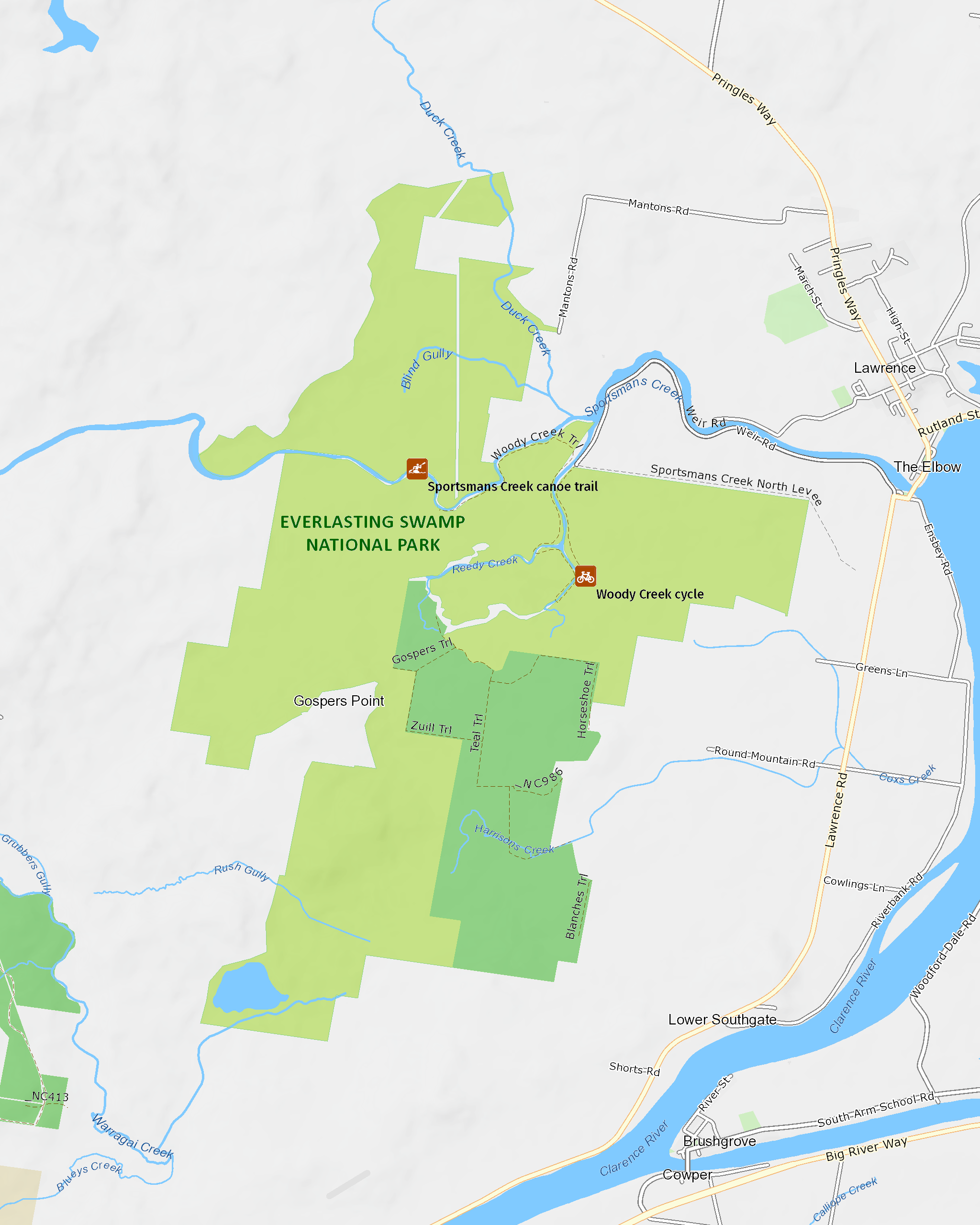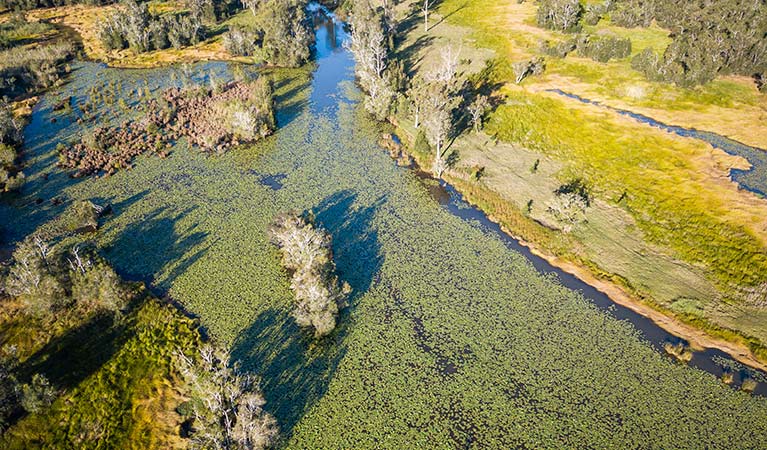Everlasting Swamp National Park
Overview
Everlasting Swamp National Park is a rare coastal wetland north of Grafton in the Clarence Valley. A hotspot for bird watching, you can explore the park and its wildlife from your canoe or bike.
Read more about Everlasting Swamp National Park
Known to bird watchers as the ‘Kakadu of the south’, Everlasting Swamp National Park is one of the largest freshwater wetlands on the NSW North Coast and protects 26 threatened species.
Take your binoculars because this park is superb for bird watching—especially after heavy rain when high water levels attract birdlife. You’ll be thrilled to discover rare birds and even glimpse their courtship dances. Keep an eye out for black-necked storks in their huge stick nests, elegant brolgas bobbing and strutting with life-long mates, and black swans escorting their downy cygnets through the wetlands.
Jump in your canoe or kayak to paddle the meandering creeks lined with reeds and giant waterlilies. Bring your fishing rod to cast a line for bass and mullet in Sportmans Creek or explore its wooded creek banks by bike. If you’ve come to relax away from the crowds, picnic on the grass beneath the shade of old red gum trees as frogs croak and birds of prey circle overhead.
Local alerts
For the latest updates on fires, closures and other alerts in this area, see https://uat.nswparks.cloud/visit-a-park/parks/everlasting-swamp-national-park/local-alerts
Contact
- in the North Coast region
Everlasting Swamp National Park is open all year, but may have to close at times due to weather conditions or fire danger.
-
-
Grafton office
02 6641 1500
Contact hours: Monday to Friday, 8.30am to 4.30pm. - Level 4, 49 Victoria Street, Grafton NSW 2460
-
Email: npws.clarence@environment.nsw.gov.au
-
Grafton office
Visitor info
All the practical information you need to know about Everlasting Swamp National Park.
Map

Map legend

Maps and downloads
Nearby towns
Maclean (22 km)
Maclean is a fishing port and service centre for the local farmlands. It's located inland on undulating terrain along the Clarence River.
Grafton (33 km)
Grafton is a gracious, historic city in the Clarence Valley farming district. It's situated on the broad Clarence River and surrounded by river flats.
Learn more
Everlasting Swamp National Park is a special place. Here are just some of the reasons why:
Plants and animals protected in this park
Animals
-

Eastern snake-necked turtle (Chelodina longicollis)
Found across most of NSW, the eastern snake-necked turtle, also known as the eastern long-necked turtle, can be found in swamps, lakes and inland waterways. This freshwater turtle is carnivorous and lives most of its life submerged on the water’s edge, searching for worms and snails.
-

Eastern water dragon (Intellagama lesueurii lesueurii)
The eastern water dragon is a subaquatic lizard found in healthy waterways along eastern NSW, from Nowra to halfway up the Cape York Pensinsula. It’s believed to be one of the oldest of Australian reptiles, remaining virtually unchanged for over 20 million years.
-

Brown-striped frog (Lymnastes peronii)
One of the most common frogs found in Australia, the ground-dwelling brown-striped frog lives in ponds, dams and swamps along the east coast. Also known as the striped marsh frog, this amphibian grows to 6.5cm across and has a distinctive ‘tok’ call that can be heard all year round.
-

Swamp wallaby (Wallabia bicolor)
The swamp wallaby, also known as the black wallaby or black pademelon, lives in the dense understorey of rainforests, woodlands and dry sclerophyll forest along eastern Australia. This unique Australian macropod has a dark black-grey coat with a distinctive light-coloured cheek stripe.
-

Tawny frogmouth (Podargus strigoides)
Found throughout Australia, the tawny frogmouth is often mistaken for an owl due to its wide, powerful beak, large head and nocturnal hunting habits. The ‘oom oom oom’ call of this native bird can be heard echoing throughout a range of habitats including heath, woodlands and urban areas.
-

Wedge-tailed eagle (Aquila audax)
With a wingspan of up to 2.5m, the wedge-tailed eagle is Australia’s largest bird of prey. These Australian animals are found in woodlands across NSW, and have the ability to soar to heights of over 2km. If you’re bird watching, look out for the distinctive diamond-shaped tail of the eagle.
-

White-bellied sea eagle (Haliaeetus leucogaster)
White-bellied sea eagles can be easily identified by their white tail and dark grey wings. These raptors are often spotted cruising the coastal breezes throughout Australia, and make for some scenic bird watching. Powerful Australian birds of prey, they are known to mate for life, and return each year to the same nest to breed.
Plants
-

Grey mangrove (Avicennia marina)
Grey mangrove is the most common and widespread mangrove found within intertidal zones across Australia, and throughout the world. Growing to a height of 3-10m, they thrive best in estuaries with a mix of fresh and salt water. They excrete excess salt through their long thick leaves, and absorb oxygen through their aerial root system.
Environments in this park
What we're doing
Everlasting Swamp National Park has management strategies in place to protect and conserve the values of this park. View the detailed park and fire management documents.
Understanding landscapes and geology
To restore Everlasting Swamp’s natural cycles, we must first know how the original wetland worked. We’re studying the complex ways its waters behave over time and under different conditions, and considering future sea level rise and climate change. We’re changing drainage and planting thousands of trees to give the over-drained wetland’s fragile soils a chance to recover.
Preserving biodiversity
Everlasting Swamp National Park is a refuge for 26 threatened species and a haven for water birds in droughts. The park also protects a rare grouping of native plants called Coastal Floodplain Wetlands. To restore this plant community, including endangered species of rushes, we plant trees and species found only locally. We’ve also improved the wetland’s ability to be a nursery for prawns and fish to support a healthy Clarence River fishery.
Managing animals, weeds and pests
We fence some areas of the wetland to keep new plantings safe from animals that would damage them. When planting, we disturb the fragile soil as little as possible to prevent weeds from getting a foothold. Water weeds, including water hyacinth, are a special challenge because they spread quickly after the wetland floods. Ongoing pig management programs help bird breeding success.
Preserving the park's historic heritage
At Everlasting Swamp National Park we preserve features from the wetland’s history to share them with you. Historic levees, water troughs, fence posts and a holding yard remind us of the landscape’s past use for cattle and crop farming.
Developing visitor facilities and experiences
We’re improving paddling, bird watching, fishing, cycling and bushwalking experiences. Our self-guided tour app is an ideal way for bird watchers to explore this biodiversity hotspot. We’ve added signage including a spot to ‘snap and share’ photos with us, so together we can record the wetland’s journey toward rejuvenation.

